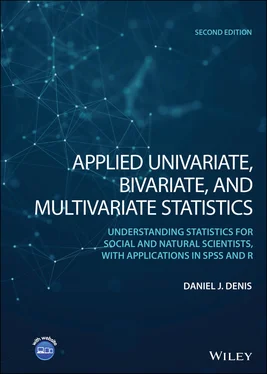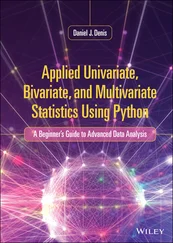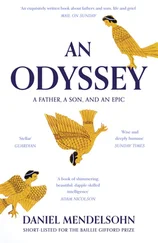1 ...6 7 8 10 11 12 ...44 In fact, much of the most rigorous science often requires the most simple and elementary of statistical tools. Students of research can often become dismayed and temporarily disillusioned when they learn that complex statistical methodology, aesthetic and pleasurable on its own that it may be (i.e., SEM models can be fun to work with), still does not solve their problems. Research wise, their problems are usually those of design, controls, and coming up with good experiments, arguments, and ingenious studies. Their problems are usually not statistical at all, and in this sense, an overemphasis on statistical complexity could actually delay their progress to conjuring up innovative, ground‐breaking scientificideas.
The cold hard facts then are that if you have poor design, weak research ideas, and messy measurement of questionable phenomena, your statistical model will provide you with anticlimactic findings, and will be nothing more than an exercise in the old adage garbage in, garbage out. Quantitative modeling, sophisticated as it has become, has not replaced the need for strict, rigorous experimental controls and good experimental design. Quantitative modeling has not made correlational research somehow more “on par” with the gold standard of experimental studies. Even with the advent of latent variable modelingstrategies and methodologies such as confirmatory factor analysisand structural equation modeling, statistics does not purport to “discover,” for real, hidden variables. Modeling is simply concerned with the partitioning of variability and the estimation of parameters. Beyond that, the remainder of the job of the scientist is to know his or her craft and to design experiments and studies that enlighten and advance our knowledge of a given field. When applied to sound design and thoughtful investigatory practices, statistical modeling does partake in this enlightenment, but it does nothing to save the scientist from his or her poorly planned or executed research design. Statistical modeling, complex and enjoyable as it may be on its own, guarantees nothing.
One might say that the ultimate goal of any science is still to establish causal relations, even if classical “Laplacian” determinism has been somewhat jettisoned by theoretical physicists, which would imply that there may actually not be “true causes” to events (despite our continued attempts to assign them). Our search for them may be entirely misguided. Still, and a bit more down to earth, nothing suggests a stronger understanding of a scientific field than to be able to speak of causation about the phenomena it studies. However, more difficult than establishing causation in a given research paradigm is that of understanding what causation meansin the first place. There exist several definitions of causality. Most definitions have at their core that causation is a relation between two events in which the second event is assumed to be a consequence, in some sense, of the first event.
For example, if I slip on a banana peel and fall, we might hypothesize that the banana peel causedmy fall. However, was it the banana peel that caused my fall, or was it the worn out soles on my shoes that I was wearing that day that caused the fall? Had I been wearing mountain climbers instead of worn‐out running shoes, I might not have fallen. Who am I to say the innocent banana peel caused my fall? Causality is hard. Even if it seems that A caused B, there are usually many variables associated with the problem such that if adjusted or tweaked may threaten the causal claim. Some would say this is simply a trivial philosophical problem of specifying causality and it is “obvious” from the situation that the banana peel caused the fall. Nonetheless, it is clear from even such a simple example that causation is in no way an easyconclusion to draw. Perhaps this is also why it is extremely difficult to pinpoint true causes of virtually any behavior, natural or social. Hindsight is 20/20, but attributing causal attributes with any kind of methodological certainty in violent crimes, for instance, usually turns out to be speculative at best. True, we may accumulate evidence for prediction, but equating that with causation is under most circumstances the wish, not the reality, of a social theory.
In our brief discussion here we will not attempt to define causality. Books, dissertations, and treatises have been written exclusively on the topic. At most, what we can do in the amount of space we have is to simply heed the following advice to the reader— If you are going to speak of causation with regard to your research, be prepared to back up your theory of causation to your audience. It is simply not enough to say A causes B without subjecting yourself to at least some of the philosophical issues that accompany such a statement. Otherwise, it is strongly advised that you avoid words such as “cause” in hypothesizing or explaining results and findings. Relationsand predictionsare much epistemologically “safer” words to use, less prone to critique ending in quicksand. For a brief, but enlightening discussion of causality in the social sciences, see Fox (1997, pp. 3–14). For a more thorough treatment of the subject as it relates to structural equation models, see Mulaik (2009, pp. 63–117). Even a brief study of the philosophy of sciencegoes a long way to understanding the complexities involved in using “causal” statements in research. These issues are not nearly as simple as they may at first appear.
1.6 THE NATURE OF MATHEMATICS: MATHEMATICS AS A REPRESENTATION OF CONCEPTS
Ian Stewart (1995) said it best when he wrote that the mathematician is not a juggler of numbers, he is a juggler of concepts. The greatest ambivalence to learning statistical modeling experienced by students outside (and even inside, I suppose) the mathematical sciences is that of the presumed mathematical complexity involved in such pursuits. Who wants to learn a mathematically-based subject such as statistics when one has “never been good at math?”
The first step in this pursuit is to critically examine assumptions and prior learned beliefs that have become implicit. One way to help “demystify” mathematics and statistics is to challenge your perception of what mathematics and statistics actually arein the first place. It is of great curiosity that so many students claim to dislike mathematics and statistics, yet at the same time cannot verbalize just what mathematics and statistics actually are, and then even worse, proceed to engage in real‐life activities that utilize very much the same analytical cognitive capacities as would be demanded from doing mathematics and statistics!
More than likely, the “dislike” of these subjects has more to do with the perceptionsone has learned to associate with these subjects than with an inherent ontological disdain for them. Human beings are creatures of psychological association. Any dislike of anything without knowing what that thing is in the first place is almost akin to disliking a restaurant dish you have never tried. You cannot dislike something until you at least know something about it and open your mind to new possibilities of what it might bethat you are forming opinions about. Not to sound overly “Jamesian,” (the analogy isn't perfect, but it's close) but perhaps you are afraid of mathematics because of your fearof it rather than the mathematics itself. That is, you run, not because of the mathematics, but because of the fear. If you accept that you are yet unsure of what mathematics is, and will not judge it until you are knowledgeable of it, it may delay derogatory opinion about it. It is only when we assume we know something (to some extent, at least) that we usually feel free to judge and evaluate it. Keep your perceptions open to revision, and what you may find is that what was disliked yesterday curiously becomes likable today, simply because you have now learned more about what that something actually is. But to learn more about it, you need to first drop, or at minimum suspend, previously held beliefs about it. Have an open mind from the outset, and refresh that mindset each time you open a book or attend a lecture in a course.
Читать дальше












